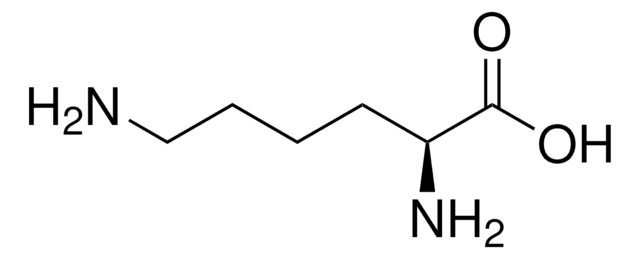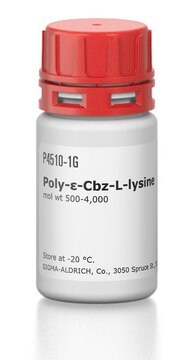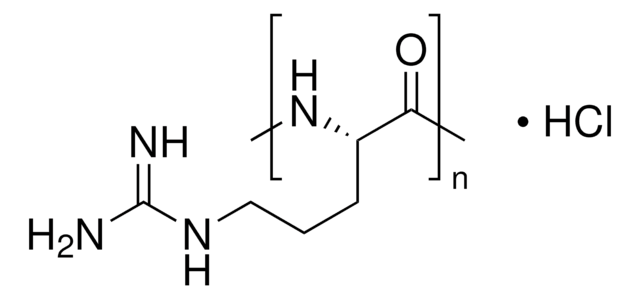P3513
Poly-L-lysine, succinylated
mol wt >50,000
Synonym(s):
Modified Lysine Copolymer
Sign Into View Organizational & Contract Pricing
All Photos(2)
About This Item
Recommended Products
form
powder or solid
Quality Level
mol wt
>50,000
color
white to faint yellow
application(s)
cell analysis
storage temp.
−20°C
Looking for similar products? Visit Product Comparison Guide
Application
Succinylated poly-L-lysine has been used to bind (Gly)3-Arg-bradykinin to study its hydrolysis by brain endopeptidases and pancreatic proteinases.
Biochem/physiol Actions
An intermediate for coupling proteins to poly-L-lysine.
Poly-L-lysine is a cationic polymer. It is mainly used for immobilizing cells to glass substrates or negatively charged substrates.
Analysis Note
Molecular weight based on precursor poly-L-lysine viscosity. Also assayed by MALLS.
Other Notes
For additional technical information on polyamino acids please visit the Polyamino acid FAQ resource.
Storage Class Code
11 - Combustible Solids
WGK
WGK 3
Flash Point(F)
Not applicable
Flash Point(C)
Not applicable
Personal Protective Equipment
dust mask type N95 (US), Eyeshields, Gloves
Choose from one of the most recent versions:
Already Own This Product?
Find documentation for the products that you have recently purchased in the Document Library.
Customers Also Viewed
V S Trubetskoy et al.
Nucleic acids research, 27(15), 3090-3095 (1999-08-24)
DNA can be condensed with an excess of poly-cations in aqueous solutions forming stable particles of submicron size with positive surface charge. This charge surplus can be used to deposit alternating layers of polyanions and polycations on the surface surrounding
Topographical Pattern Dynamics in Passive Adhesion of Cell Membranes
Alina Hategan
Biophysical Journal, 87(5), 3547?3560-3547?3560 (2004)
Effects of poly(L-lysine) substrates on attached Escherichia coli bacteria.
Colville K
Langmuir, 26(4), 2639-2644 (2010)
M R Hamblin et al.
British journal of cancer, 89(5), 937-943 (2003-08-28)
Conjugates between photosensitisers (PS) and charged polymeric carriers are under investigation for photodynamic therapy of cancer and may allow targeting to certain cell types or compartments in tumours. Covalent attachment of polyethylene glycol to macromolecules (pegylation) may alter their pharmacokinetics
Susceptibility of a Peptide Derived from Bradykinin to Hydrolysis by Brain Endo-oligopeptidases and Pancreatic Proteinases*
Antonio C. M. Camargo
The Journal of Biological Chemistry, 254(12), 5304-5307 (1979)
Our team of scientists has experience in all areas of research including Life Science, Material Science, Chemical Synthesis, Chromatography, Analytical and many others.
Contact Technical Service






